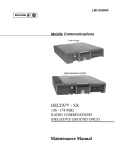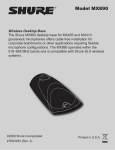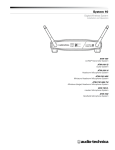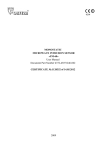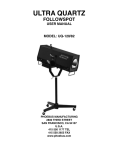Download Delta 403 Specifications
Transcript
LBI-31567 Mobile Communications 65-110 WATT MOBILE RADIO DELTA-S NARROW BAND, SYNTHESIZED 403-430-450-512 MHz Mobile Communications (NEGATIVE GROUND ONLY) Maintenance Manual LBI-31567 TABLE OF CONTENTS MILITARY SPECIFICATIONS . . . . SYSTEM SPECIFICATIONS . . . . . COMBINATION NOMENCLATURE STRUCTURED OPTIONS . . . . . . . DESCRIPTION . . . . . . . . . . . . . FREQUENCY SYNTHESIZER . . EEPROM . . . . . . . . . . . . . . PROGRAMMING . . . . . . . . . TRANSMITTER . . . . . . . . . . RECEIVER . . . . . . . . . . . . . CONTROL UNITS . . . . . . . . . CHANNEL SELECTION . . . . . MICROPHONE AND HANDSET HOOKSWITCHES . . . . . . . . . SPEAKER . . . . . . . . . . . . . . INITIAL ADJUSTMENT . . . . . . . . TRANSMITTER ADJUSTMENT . RECEIVER ADJUSTMENT . . . . OPERATION . . . . . . . . . . . . . . TO RECEIVE A MESSAGE . . . TO TRANSMIT A MESSAGE . . MAINTENANCE . . . . . . . . . . . . . . . . . . . . . . . . . . . . . . . . . . . . . . . . . . . . . . . . . . . . . . . . . . . . . . . . . . . . . . . . . . . . . . . . . . . . . . . . . . . . . . . . . . . . . . . . . . . . . . . . . . . . . . . . . . . . . . . . . . . . . . . . . . . . . . . . . . . . . . . . . . . . . . . . . . . . . . . . . . . . . . . . . . . . . . . . . . . . . . . . . . . . . . . . . . . . . . . . . . . . . . . . . . . . . . . . . . . . . . . . . . . . . . . . . . . . . . . . . . . . . . . . . . . . . . . . . . . . . . . . . . . . . . . . . . . . . . . . . . . . . . . . . . . . . . . . . . . . . . . . . . . . . . . . . . . . . . . . . . . . . . . . . . . . . . . . . . . . . . . . . . . . . . . . . . . . . . . . . . . . . . . . . . . . . . . . . . . . . . . . . . . . . . . . . . . . . . . . . . . . . . . . . . . . . . . . . . . . . . . . . . . . . . . . . . . . . . . . . . . . . . . . . . . . . . . . . . . . . . . . . . . . . . . . . . . . . . . . . . . . . . . . . . . . . . . . . . . . . . . . . . . . . . . . . . . . . . . . . . . . . . . . . . . . . . . . . . . . . . . . . . . . . . . . . . . . . . . . . . . . . . . . . . . . . . . . . . . . . . . . . . . . . . . . . . . . . . . . . . . . . . . . . . . . . . . . . . . . . . . . . . . . . . . . . . . . . . . . . . . . . . . . . . . . . . . . . . . . . . . . . . . . . . . . . . . . . . . . . . . . . . . . . . . . . . . . . . . . . . . . . . . . . . . . . . . . . . . . . . . . . . . . . . . . . . . . . . . . . . . . . . . . . . . . . . . . . . . . . . . . . . . . . . . . . . . . . . . . . . . . . . . . . . . . . . . . . . . . . . . . . . . . . . . . . . . . . . . . . . . . . . . . . . . . . . . . . . . . ILLUSTRATIONS FIGURE 1 - TYPICAL MODULE LAYOUT . . . . . . . . . . . . . . . . . . . . . . . . . . . . . . . . . . . 3 3 6 6 7 8 8 8 8 8 8 9 9 9 9 9 9 10 10 10 10 10 7 WARNING Although the highest DC voltage in Mobile Two-Way Radio Equipment is supplied by the vehicle battery, high currents may be drawn under short circuit conditions. These currents can possibly heat objects such as tools, rings, watchbands, etc., enough to cause burns. Be careful when working near energized circuits. High-level RF energy in the Transmitter Power Amplifier assembly can cause burns upon contact. Keep away from these circuits when the transmitter is energized! Copyright© November 1985, General Electric Company 2 LBI-31567 MILITARY SPECIFICATIONS STANDARD METHODS/PROCEDURES MIL-STD-810-C MIL-STD-810-D Low Pressure 500.1/Procedure 1 500.2/Procedure 1 High Temperature 501.1/Procedure 1,2 501.2/Procedure 1,2 Low Temperature 502.1/Procedure 1 502.2/Procedure 1,2 Temperature Shock 503.1/Procedure 1 503.2/Procedure 1 Solar Radiation 505.1/Procedure 1 505.2/Procedure 1 Humidity 507.1/Procedure 2 507.2/Procedure 2 Vibration 514.2/Procedure 8, 10 514.3/Procedure 1 Shock 516.2/Procedure 1,2,3,5 516.3/Procedure 1, 3, 4, 5, 6 SYSTEM SPECIFICATIONS* FREQUENCY RANGE 403-430 MHz** & 450-512 MHz BATTERY VOLTAGE 13.8 volts ±20% RX 13.6 or 13.4 volts ±20% TX BATTERY DRAIN (Maximum) Receive Squelched Unsquelched Transmit 35/40 watts 30 watts (DOC***) 50 watts 80 watts 90 watts 100 watts 0.7 amperes 2.2 amperes 10.0 amperes at 13.6 volts 10.0 amperes at 13.6 volts 12.0 amperes at 13.6 volts 21.0 amperes at 13.4 volts 22.0 amperes at 13.4 volts 23.0 amperes at 13.4 volts FREQUENCY STABILITY 0.0005% or optional 0.0002% TEMPERATURE RANGE -30°C (-22°F) to +60°C (140°F) DUTY CYCLE 100% Receive, 20% Transmit (EIA) DIMENSION, LESS ACCESSORIES (H x W x D) 35-50 watts 80-100 watts WEIGHT, LESS ACCESSORIES 35-50 watts 80-100 watts 65 mm x 260 mm x 325 mm (2.5 x 10.2 x 12.7 inches) 65 mm x 290 mm x 325 mm (2.5 x 11.4 x 12.7 inches) 5.9 kg (12.9 pounds) 6.5 kg (14 pounds) * These specifications are intended primarily for the use of the serviceman. Refer to the appropriate Specifications Sheet for the complete specifications. ** 403-430 MHz combinations are for International use (50 Watt Transmitters). 421-430 MHz combinations may be used for domestic applications. *** Canadian Department of Transportation. 3 LBI-31567 GENERAL FCC FILING NUMBER (see table below): RECEIVER TRANSMITTER OSCILLATOR STABILITY POWER OUTPUT FREQUENCY KT-218-B KT-220-B KT-221-B KT-223-B KT-221-C KT-223-C ±5 PPM ±5 PPM ±5 PPM ±5 PPM ±5 PPM ±5 PPM 40 WATTS 100 WATTS 35 WATTS 90 WATTS 35 WATTS 80 WATTS 450-470 MHz 450-470 MHz 470-494 MHz 470-494 MHz 494-512 MHz 494-512 MHz KT-218-B2 KT-220-B2 KT-221-B2 KT-223-B2 KT-221-C2 KT-223-C2 ±2 PPM ±2 PPM ±2 PPM ±2 PPM ±2 PPM ±2 PPM 40 WATTS 100 WATTS 35 WATTS 90 WATTS 35 WATTS 80 WATTS 450-470 MHz 450-470 MHz 470-494 MHz 470-494 MHz 494-512 MHz 494-512 MHz ER-140-B ER-140-C ER-140-D ER-140-B ER-140-C ER-140-D DOC FILING NUMBER: RSS-119 TRANSMITTER CONDUCTED SPURIOUS -85 dB MODULATION ±4.5 kHz AUDIO SENSITIVITY 70 to 120 millivolts AUDIO FREQUENCY CHARACTERISTICS Within +1 dB to -4.5 dB of a 6 dB/octave pre-emphasis from 300 to 3000 Hz per EIA standards. Post limiter filter standards per FCC and EIA. DISTORTION Less than 2% (1000 Hz) Less than 5% (300 to 3000 Hz) DEVIATION SYMMETRY 0.5 kHz maximum MAXIMUM FREQUENCY No Center Tuning Center Tuning 6 MHz 5 MHz 12 MHz 10 MHz 450-512 MHz 403-430 MHz 4 RF OUTPUT IMPEDANCE 50 ohms POWER OUTPUT Rated Power ±0.5 dB LBI-31567 RECEIVER AUDIO OUTPUT (to 4.0 ohm speaker) 12 Watts with less than 3% distortion. SENSITIVITY 12 dB SINAD (EIA Method) 20 dB Quieting Method Standard 0.35 mV UHS Preamp 0.20 mV 0.50 mV 0.25 mV SELECTIVITY EIA Two-signal Method -90 dB -90 dB SPURIOUS RESPONSE -100 dB -90 dB INTERMODULATION -85 dB -80 dB MODULATION ACCEPTANCE ±7.0 kHz SQUELCH SENSITIVITY 8 dB SINAD MAXIMUM FREQUENCY SPREAD No Center Tuning 1 MHz Center Tuning 2 MHz 1 dB degradation with Center Tuning 2.5 MHz FREQUENCY RESPONSE Within +2 and -8 dB of a standard 6 dB per octave de-emphasis curve from 300 to 3000 Hz (1000 Hz reference). RF INPUT IMPEDANCE 50 ohms 5 LBI-31567 COMBINATION NOMENCLATURE Digits 1 & 2 Digit 3 Digit 4 Digit 5 Digit 6 Digits 7-9 Digit 10 Digit 11 Product Code Transmit Frequency Range Receive Frequency Range Channel Spacing Type RF Power Output Frequency Capacity Oscillator Stability N3 R R 2 N 035 T DELTA S 403-430 MHz 403-430 MHz 25 kHz Narrow Band 35 Watts 16 Channel A ±2 PPM U U 040 Z 450-470 MHz 450-470 MHz 40 Watts 32 Channel ±5 PPM V V 050 470-494 MHz 470-494 MHz 50 Watts W W 090 494-512 MHz 494-512 MHz 90 Watts A 100 100 Watts STRUCTURED OPTIONS DigitA Digit C Digit D Digit F Digit M Digit N Digit R Digit V Programming Option Channel Guard Fuse Mounting Antenna Receiver Type Voice Guard O O O O O O O O Test Program None None Standard Std Frame & Mtg Hdwe None None None 1 N B N N A A G Customer Program MII Interface Tone/ Digital None None Whip UHS Pre Ampl Voice Guard 2 S950 Download 6 LBI-31567 DESCRIPTION General Electric DELTA-S mobile radio combinations are completely solid state utilizing microcomputer technology and integrated circuits to provide high quality - high reliability radios. The DELTA-S radio is designed for use in vehicles having a negative ground battery system. In vehicles having a positive ground battery system a polarity converter must be used. Standard combinations may be equipped with: • Microcomputer Controlled Frequency Synthesizer • Up to 32 channels • 0.0002% or 0.0005% frequency stability • UHS Preamplifier (Ultra High Sensitivity), optional • Tone and/or Digital Channel Guard, optional The radio set is housed in a weather resistant case only 2 1/2 inches high. The radio is secured to the vehicle by a bottom mounting plate, and is tamper proof when locked into the plate. When unlocked, the handle can be pulled out of the mounting plate or the top cover removed for servicing. When pulled down, the handle can be used to carry the radio. The PA board is inserted into the radio from the top of the frame, while the TRS board is inserted from the bottom. There are no wires used in the basic radio. Interconnections are provided by pins on the TRS board that mate with connectors on the PA assembly. A power bus connects A+ and A- from the front connector to the PA assembly. The PA board is isolated from ground (floating). Power is supplied directly from the battery to the PA power output stage. The radio is of single-layer construction with all major modules and tuning adjustments easily accessible from the top of the radio. Centralized metering jacks for the transmitter, receiver and system functions are provided for simplified alignment and troubleshooting. Figure 1 - Typical Module Layout 7 LBI-31567 Excluding option boards, the basic radio mounted in a cast aluminum frame. The two boards are the transmitterreceiver-system (TRS) board 19D9901620G1 and the power amplifier board (see Figure 1). The TRS board is connected to chassis ground allowing it to be used in vehicles with a negative ground battery system only. Option boards include the Channel Guard board and VG Interface board. The VG Interface board is used in radios equipped with Voice Guard. Alternatively, a single channel Programmer Model 4EX22A10 allows the user to reprogram the radio on a per channel basis. This programmer requires the removal of the radio top cover and any option boards present. A special programming jack, J711, is provided in the radio for interconnections. FREQUENCY SYNTHESIZER TRANSMITTER The frequency synthesizer consists of a microcomputer, electrically erasable PROM(S) (EEPROM), a frequency synthesizer IC, transmit and receive VCO’s and associated circuitry. The frequency synthesizer under control of the microcomputer generates all transmit and receive RF frequencies. The transmitter consists of the exciter, frequency synthesizer, TX VCO, and a power amplifier assembly. The PA assembly consists of a PA board mounted along the side of the radio next to the heat sink assembly. The PA board also contains a hermetically sealed antenna relay and a low pass filter. EEPROM RECEIVER The EEPROM stores binary data for all RF frequencies, Channel Guard tones/digital codes, and the timing function of the Carrier Control Timer (CCT). The microcomputer accesses the EEPROMS and provides the correct WALSH bits to the Channel Guard board to generate the correct Channel Guard tone or digital code on a per channel basis. The receiver consists of the frequency synthesizer, RX VCO, injection amplifiers, front end, IF and limiter detector. In UHS receivers, a pre-amplifier board is added in the receiver front end. Audio and squelch circuitry for the receiver is located in the system section of the TRS board. Jacks for the Channel Guard and other structured options are also located in the system area. PROGRAMMING CONTROL UNITS The EEPROM allows the radio to be reprogrammed as needed to adapt to changing system requirements. RF frequencies, Channel Guard tones and digital codes, and the CCT function can be reprogrammed. Several "S" series control units are available for use with the DELTA-S radio combinations. Depending on the configuration of the radio, one or two EEPROMs may be provided. Radios not equipped with a MODE A/B switch will have one EEPROM. Radios with more than 16 channels and those with the MODE switch will have two EEPROMs. Programming instructions are provided in the respective Programmer Maintenance Manuals. The S-500 control unit contains an on-off volume control switch, a rotary channel selector switch for 1, 8, or 16 channels, a MODE A/B switch (optional) to expand the channel select capability to 32, seven segment channel indicator(s), a red transmit indicator, channel busy indicator (optional), and an external tone option jack. Options that may be used with this control unit include Type 90 and 99 tone, squelch operated relay SOR, GE-STAR encoder, and public address. NOTE When programming, remember that all RF frequencies must be divisible by 12.5 kHz. The EEPROMs can be reprogrammed through the radio front connector using the General Electric Universal PROM Programmer Model TQ2310. This programmer allows all information to be loaded simultaneously. 8 The S-600 control unit contains an on-off volume control switch, squelch disable switch, red transmit indicator, and a seven segment channel indicator. A rotary channel select switch permits selection of up to eight channels. A white power-on indicator is used for back lighting the front panel. Space is provided for two optional push-button switches and two optional indicators. The S-900 series control units designed specifically for the DELTA class radios are highly versatile, software LBI-31567 controlled units providing numerous functions and options including: • Dual Priority Scan • Digital Volume Control • Digital Squelch Control • Type 90 or 99 Encode Tones An optional telephone-type handset is available for use with the radio. The handset uses a dynamic microphone with a built in microphone pre-amplifier. The extendable coiled cord plugs into the microphone jack on the back of the control unit, and is secured to the jack by a retaining screw. HOOKSWITCHES • GE-STAR Identification • 128 Channels in 8 Modes of 16 Channels each or 4 Modes of 32 Channels each In Channel Guard or other tone applications, a microphone or handset hookswitch is supplied with the radio. The hookswitches are equipped with a Channel Guard disable switch. • Carrier Control Timer (per mode basis)* Placing the switch in the "up" position (towards the small speaker symbol) disables the Channel Guard decoder. With the switch in the "down" position, the Channel Guard is disabled when the microphone or handset is removed from the hookswitch. • Channel Guard - Tone or Digital* • Channel Frequencies* • Home Channel Revert • Auxiliary Relay Control * These features are actually performed in the radio. If you have downloaded, the data is stored in the control unit. CHANNEL SELECTION Depending on the control unit used, a single rotary or push-button selector switch will select up to 16 channels. In radios equipped with more than 16 channels, the control unit contains a MODE A/B switch. The MODE switch allows the user to select a second set of 16 channels (17-32). The MODE A/B switch may be used to provide mobile-to-mobile communications through an intermediate repeater (repeated path) or direct mobile-to-mobile communications. For example, channel 1 Mode A may be programmed for the repeater frequency (repeated path) while channel 1 Mode B would be programmed for the mobile receive frequency (direct path). Judicious programming will allow selection of repeated or direct communications paths on selected channels. MICROPHONE AND HANDSET A hand-held microphone with a built-in, transistorized microphone pre-amplifier is available for use with the radio. The microphone is housed in a sturdy two-piece case, and the extendable coiled cord plugs into the microphone jack at the back of the control unit. The plug is secured to the jack by a retaining screw. SPEAKER A three by five-inch speaker contained in a molded plastic housing provides an audio output of 12 watts with a speaker impedance of four ohms. The speaker leads are terminated in Vehicle Systems Plug P3 which connects to J1-A on the rear of the control unit. INITIAL ADJUSTMENT After the radio has been installed (as described in the Installation Manual), the following adjustments should be made by a certified electronics technician. TRANSMITTER ADJUSTMENT The transmitter adjustments include measuring the forward and reflected power and optimizing the antenna length, then setting the transmitter to rated power output. Next, measuring the frequency and modulation and recording these measurements for future reference. For the complete transmitter adjustment, refer to the Alignment Procedure in the service section of this manual. RECEIVER ADJUSTMENT The initial adjustment for the receiver includes tuning the input circuit to match the antenna. Refer to the Front End Alignment Procedures in the service section of this manual. 9 LBI-31567 OPERATION 3. Complete operating instructions for the Two-Way Radio are provided in the Operator’s Manual. The basic procedures for receiving and transmitting messages in mobile combinations are as follows: Pick up the microphone and listen briefly to the speaker to make sure that no one else is using the channel. 4. Press the Push-To-Talk (PTT) switch on the microphone and send the message. The red transmit light on the control unit will glow each time the PTT switch is pressed. TO RECEIVE A MESSAGE MAINTENANCE 1. Turn the radio on by turning the OFF-VOLUME control halfway to the right. 2. Turn the SQUELCH control clockwise (to the right) as far as possible. A noise will be heard from the speaker. 3. Adjust the VOLUME control for the desired listening level. 4. Turn the SQUELCH control counter-clockwise to the left until the noise just cuts off. 5. In multi-frequency radios, select the desired channel. The radio is now operational. TO TRANSMIT A MESSAGE 1. Turn the radio on and select the proper channel. 2. If a lengthy message (or several messages) are to be sent, the vehicle engine should be running to maintain the battery charge. The use of microcomputer technology allows self-diagnostic maintenance routines to be incorporated in the microcomputer software. These routines are easy to run and provide a quick analysis of microcomputer and frequency synthesizer operation. The service section of this manual contains the diagnostic routines and other maintenance information to service this radio. The service section includes: • System interconnection • Mechanical layout • Disassembly procedures • Replacement of IC’s, chip capacitors, and resistors • Microcomputer self-diagnostics • Alignment procedures for the transmitter and receiver • Troubleshooting flow charts and waveforms Printed in U.S.A. 10










